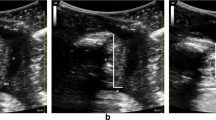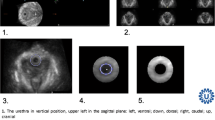Abstract
Introduction and hypothesis
Ultrasound measurement of urethral mobility is an attractive approach to directly visualize bladder neck descent (BND) during stress. BND assessed by transperineal ultrasound appears to be associated with stress urinary incontinence (SUI) severity. This study evaluated the inter- and intra-observer reliability of ultrasound BND measurement and its correlation with clinical examination.
Methods
We included 50 women from the multicenter randomized 3PN study (“Prenatal Perineal Prevention”). BND was measured by two operators either during pregnancy (at 20 weeks of gestation) or 2 months after delivery. Two measurements were taken by each operator. Intra-class coefficient correlations were used for analysis. Urethral mobility was clinically assessed by measuring the point Aa of the POP-Q classification during maximum strain (Valsalva maneuver) with an empty bladder.
Results
Ultrasound analysis showed high intra-observer reliability in the overall population: intraclass correlation coefficients (ICC) = 0.75 (0.59–0.85) and 0.73 (0.55–0.84) for each operator. Intra-observer agreements were considered moderate to high in the post- and antepartum groups. Inter-observer agreements were moderate in the antepartum period [ICC = 0.58 (0.26–0.78) for the first measurement and 0.68 (0.42–0.84) for the second] but low in the postpartum period [ICC = 0.15 (0.10–0.41) and 0.21 (0.10–0.58)]. Correlations between ultrasound and clinical measurements were considered low to moderate (Spearman coefficient, rho = 0.34 and 0.50 for post- and antepartum periods, respectively).
Conclusions
Inter-observer reliability of ultrasound urethral mobility measurements by the transperineal route is moderate antepartum and low postpartum. The correlation with point Aa is low to moderate.


Similar content being viewed by others
References
Minassian VA, Drutz HP, Al-Badr A. Urinary incontinence as a worldwide problem. Int J Gynaecol Obstet. 2003;82:327–38.
Hannestad YS, Rortveit G, Sandvik H, Hunskaar S. A community-based epidemiological survey of female urinary incontinence: the Norwegian EPINCONT study Epidemiology of Incontinence in the Country of Nord-Trondelag. J Clin Epidemiol. 2000;53:1150–7.
DeLancey JO, Trowbridge ER, Miller JM, Morgan DM, Guire K, Fenner DE, et al. Stress urinary incontinence: relative importance of urethral support and urethral closure pressure. J Urol. 2008;179(6):2286–90.
DeLancey JO. Structural support of the urethra as it relates to stress urinary incontinence: the hammock hypothesis. Am J Obstet Gynecol. 1994;170(6):1713–20.
Karram MM, Bhatia NN. The Q-tip test: standardization of the technique and its interpretation in women with urinary incontinence. Obstet Gynecol. 1988;71:807–11.
Tapp K, Connolly A, Visco AG. Evaluation of aa point and cotton-tipped swab test as predictors of urodynamic stress incontinence. Obstet Gynecol. 2005;105:115.
Rosencrantz M, Menefee SA, Lukacz ES. The correlation of urethral mobility and point aa of the pelvic organ prolapse quantification sys- tem before and after surgery. Am J Obstet Gynecol. 2006;195:1841–5.
Noblett K, Lane FL, Driskill CS. Does pelvic prolapse quantification exam predicts urethral mobility in stages 0 and I prolapse. Int Urogynecol J. 2005;16:268–71.
Pizzoferrato AC, Fauconnier A, Bader G. Value of ultrasonographic measurement of bladder neck mobility in the management of female stress urinary incontinence. Gynecol Obstet Fertil. 2011;39(1):42–8.
Dietz HP, Steensma AB, Eldridge A, Grace M, Clarke B. Test-retest and interrater reliability of the ultrasound assessment of bladder neck mobility. In: International Urogynecological association (IUGA) conference; 2003.
Fritel X, Fauconnier A, de Tayrac R, Amblard J, Cotte L, Fernandez H. Prevent postnatal urinary incontinence by prenatal pelvic floor exercise? Rationale and protocol of the multicenter randomized study PreNatal pelvic floor prevention (3PN). J Gynecol Obstet Biol Reprod. 2008;37(5):441–8.
Dietz HP. Ultrasound imaging of the pelvic floor. Part I: two-dimensional aspects. Ultrasound Obstet Gynecol. 2004;23:80–92.
Bump RC, Mattiasson A, Bo K, Brubaker LP, DeLancey JO, Klarskov P. The standardization of terminology of female pelvic organ prolapse and pelvic floor dysfunction. Am J Obstet Gynecol. 1996;175(1):10–7.
Shrout PE, Fleiss JL. Intraclass correlations: uses in assessing rater reliability. Psychol Bull. 1979;2:420–8.
Bland JM, Altman DG. Statistical methods for assessing agreement between two methods of clinical measurement. Lancet. 1986;1:307–10.
Hinkle DE, Wiersma W, Jurs SG. Applied statistics for the behavioral sciences. 5th ed. Boston: Houghton Mifflin; 2003.
Creighton SM, Pearce JM, Stanton SL. Perineal video-ultrasonography in the assessment of vaginal prolapse: early observation. BJOG. 1992;99(4):310–3.
Schaer GN, Koechli OR, Schuessler B, Haller U. Perineal ultrasound for evaluating the bladder neck in urinary stress incontinence. Obstet Gynecol. 1995;85:220–4.
Salvatore S, Serati M, Uccella S, Koelbl H, Artibani W, Cardozo L, et al. Inter-observer reliability of three different methods of measuring urethrovesical mobility. Int Urogynecol J. 2008;9:1513–7.
Peschers UM, Fanger G, Schaer GN, Vodusek DB, DeLancey JO, Schuessler B. Bladder neck mobility in continent nulliparous women. BJOG. 2001;108(3):320–4.
Reddy AP, DeLancey JO, Zwica LM, Ashton-Miller JA. On-screen vector-based ultrasound assessment of vesical neck movement. Am J Obstet Gynecol. 2001 Jul;185(1):65–70.
Dietz HP, Nazemian K, Shek K, Martin A. Can urodynamic stress incontinence be diagnosed by ultrasound? Int Urogynecol J. 2013;24:1399–403.
Wlazlak E, Kluz T, Kociszewski J, Frachowicz K, Janowska M, Wlazlak W, et al. The analysis of repeatability and reproducibility of bladder neck mobility measurements obtained during pelvic floor sonography performed introitally with 2D transvaginal probe. Ginekol Pol. 2017;88(7):360–5.
Pizzoferrato AC, Fauconnier A, Bader G, de Tayrac R, Fort J, Fritel X. S prenatal urethral descent a risk factor for urinary incontinence during pregnancy and the postpartum period? Int Urogynecol J. 2016;27(7):1003–11.
Dietz HP, Wilson PD. The influence of bladder volume on the position and mobility of the Urethrovesical junction. Int Urogynecol J. 1999;10:3–6.
Orno A, Dietz HP. Levator co-activation is a significant confounder of pelvic organ descent on Valsalva maneuver. Ultrasound Obstet Gynecol. 2007;30:346–50.
Dietz HP, Steensma AB, Hastings R. Three-dimensional ultrasound imaging of the pelvic floor: the effect of parturition on paravaginal support structures. Ultrasound Obstet Gynecol. 2003;21(6):589–95.
Cogan SL, Weber AM, Hammel JP. Is urethral mobility really being assessed by the pelvic organ prolapse quantification (POP-Q) system. Obstet Gynecol. 2002;99(3):473–6.
Author information
Authors and Affiliations
Corresponding author
Ethics declarations
Conflicts of interest
The authors declare that they have no conflict of interest.
Additional information
Publisher’s note
Springer Nature remains neutral with regard to jurisdictional claims in published maps and institutional affiliations.
Rights and permissions
About this article
Cite this article
Pizzoferrato, AC., Nyangoh Timoh, K., Bader, G. et al. Perineal ultrasound for the measurement of urethral mobility: a study of inter- and intra-observer reliability. Int Urogynecol J 30, 1551–1557 (2019). https://doi.org/10.1007/s00192-019-03933-w
Received:
Accepted:
Published:
Issue Date:
DOI: https://doi.org/10.1007/s00192-019-03933-w




